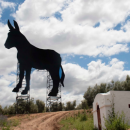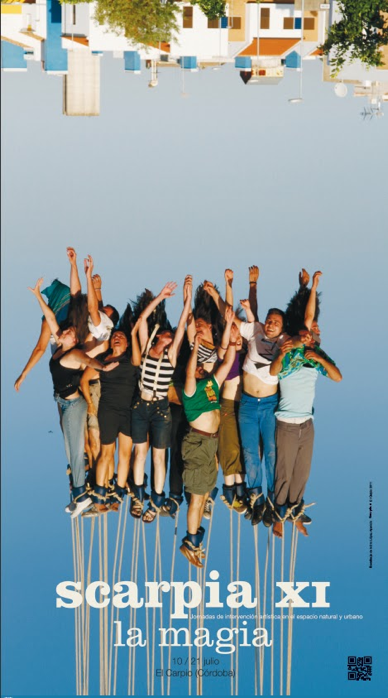Lab:
The Lab is a source of information for Artists and Art Lovers alike. You can find useful information to help develop your career as an artist such as tutorials, interviews, news, and a lot more!

The Scarpia project, or how to introduce public art into a rural setting.
We spoke to Miguel A. Moreno Carretero who told us about Scarpia, the artistic project he directs in El Carpio, Córdoba. For 12 years Scarpia has been organising artistic interventions in the natural and urban spaces of El Carpio, as well as organising workshops with artists of international renown to bring public art the children (Scarpia Juinior) and to the elderly (Scarpia Plus). Scarpia has, over the years, become an example to be followed in terms of its dissemination of art and public art, especially in Andalucía, but also in the rest of Spain.
What is Scarpia?
Scarpia is an artistic project that aims to analyse and put into practice teachings to do with a kind of art known as ´Outside´ art (public art, participative art, social art, projects of intervention in nature) and has been organising outings to promote these disciplines, for the past eleven years.

How, when and why was Scarpia born?
Scarpia is born of the personal interest of the Artist Miguel A. Moren Carretero, a first year Fine Arts student, and art historian Antonia R. Sánchez Gavilan, both of whom have ties to the village of El Carpio. The town hall of El Carpio offers some help for summer workshops and decided to hold a workshop learning about the theory and practice of Land Art artists, local people being the direct recipients.
What are Scarpia´s objectives?
On one hand to fill a training gap in the teaching of art in relation to public art (above all on a practical level, in the Andalucia region), bringing young creators together with prestigious artists who can spell out the formal and theoritical aspects of this kind of project, and also, from the point of view of the village, there is the universal meaning derived from the different forms ofcontemporary visual expression, being conscious of the social and educational importance of this type of installation.
How many people make Scarpia a reality?( Is it voluntary?)
Scarpia is composed of a team distributed in the following way:
Education: Artists with links to teaching and monitors of the Scarpia junior and Scarpia Plus sites.
Production: townhall personel: one or two depending on the proposal and their availability.
Documentation: a photography artist, a video documentary artist.
Curator of the Torre exhibitions, and assistant on outings.
Coordinator: person responsible for things like accomodation, production, the reception of artists and communication
Management: Curator and director of Scarpia: Miguel A. Moreno Carretero.
Volunteers: young artists, students of fine arts or art history and people of the village who for selfless reasons take it upon themselves to guard the exhibitions and help in the production of field trips (in return they receive maintenance, accomodation and free tuition)
What kind of body are you? An association? A collective? A public institution?
Scarpia is set up as a cultural management company, onsight, open-field training (workshops and courses) and publishing, organising cycles and trips.
Why a company?
Its being set up as a company is due to the fact that the director and curator are dedicated to it full time, that being their professional field. The development process for establishing an association didn´t work for us because of the difficulty of creating and advancing projects owing to territorial questions and different interests amongst its possible members
You are from Carpio, the very place chosen by Fernando Sánchez Castillo for producing one of his latest works, besides being the definitive location of his famous work entitled Burro Grande.
How did you come into contact with Fernando Sánchez Castillo?
Scarpia has spread by word of mouth by artists how have had a good time on the outings, creating a network that allows us a lot of contact with prestigious artists and with those who have confidence in our project.
We made contact with Fernando Sánchez Castillo through another artist with links to Scarpia: Alicia Martín.
Fernando visited El Carpio during the Scarpia VIII field trips. He lead one of the workshops
He invited us to participate in the meeting where he presented this piece. One of the most important things about this meeting was hosting an art project and situating it in an a place with such a big audience. According to the judge, we came closest to bringing together the qualities they were looking for, it is, furthermore, a work that has not only brought us visibility but has strengthened Scarpia locally, as well as nationally and internationally.
Do you find it difficult to show and promote art, within Spain, away from the big cities like Madrid and Barcelona? Are there aids that facilitate the task? What is the most difficult part?
We feel its very diffcult especially when one leaves the parameters of contemprary society. In our case, in rural environs, we find acceptance and comprehension of the project very difficult. However I think that by having a playful, participitive element, the spectator enjoys it in another way and in the end becomes an complicit in the work.
The education in visual arts is usually distanced from basic teaching and I believe this is a mistake, beginning with our own parents and teachers who don´t assimilate or aren´t in the habit of going to the places where these types of proposals gestate(art centres, musuems,conferences, meetings)
It is much more normal to see a family in a museum in other European countries than in Spain. The majority of young people who go into a musuem for the first time do so at the guidance of their teacher at the institute or on an excursion, without having experienced it before had as something normal to do any Saturday of the year.
With respect to the grants it is clear that there are increasingly less, which makes difficult the task of applying teaching plans to these proposals.
What advice would you give to emerging creators to give a boost to their artistic careers
Travel, contrast your training with that of other artists, visualise in what way you are failing in your work and try to solve it, get to know yourself more personally and understand that you have the power in your hands to make things happen.
Be conscious of the fact that there is no concept of a ´goal´ or of success in art.
Believe in your work and that art is a way of life and not a way of earning a living.


